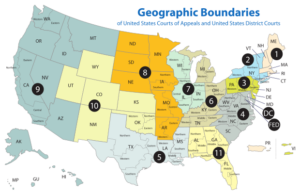The United States federal court system is a hierarchical structure consisting of three levels: the district courts, the courts of appeals, and the Supreme Court. District courts are trial-level courts who have jurisdiction over a wide range of federal cases, including criminal cases, civil cases involving federal law, and cases involving federal agencies. The courts of appeals are intermediate appellate courts, who hear appeals from the district courts and other federal agencies within their geographic jurisdiction. The Supreme Court is the highest court in the United States, and has the final say on all cases involving federal law and the United States Constitution.
 The federal court system was established by the Constitution, which gives Congress the power to create and regulate federal courts. Our first federal courts were created by the Judiciary Act of 1789, which only established district courts and the Supreme Court. The Act also created the Office of the Attorney General and provided for the appointment of federal judges by the President, with the advice and consent of the Senate.
The federal court system was established by the Constitution, which gives Congress the power to create and regulate federal courts. Our first federal courts were created by the Judiciary Act of 1789, which only established district courts and the Supreme Court. The Act also created the Office of the Attorney General and provided for the appointment of federal judges by the President, with the advice and consent of the Senate.
Over time, the federal court system has evolved and expanded to meet our country’s changing needs. The number of federal district courts and judges has increased while new courts of appeals have been established.
The United States Court of Appeals for the Sixth Circuit (in case citations, 6th Cir.) is a federal court with appellate jurisdiction over the district courts for the following districts:
- Eastern District of Kentucky
- Western District of Kentucky
- Eastern District of Michigan
- Western District of Michigan
- Northern District of Ohio
- Southern District of Ohio
- Eastern District of Tennessee
- Middle District of Tennessee
- Western District of Tennessee
The court is composed of sixteen judges and is based at the Potter Stewart U.S. Courthouse in Cincinnati, Ohio. It is one of 13 United States courts of appeals.
Here are some landmark cases derived from the Sixth Circuit:
- Baker v. Carr (1962) – held that federal courts had the power to hear claims of unequal apportionment of legislative districts.
- Obergefell v. Hodges (2015) – held that the Fourteenth Amendment requires states to license same-sex marriages and recognize same-sex marriages performed in other states.
- United States v. Michaud (2015) – ruled that the government may use GPS technology to monitor a suspect’s movements without a warrant.
- United States v. Bredimus (2018) – held that the “third-party doctrine” does not apply to cell site location information (CSLI), meaning that a warrant is required for the government to access such information.
- EEOC v. AutoZone (2012) – held that Title VII of the Civil Rights Act of 1964 prohibits employers from retaliating against employees who support discrimination claims.
These cases reflect the Sixth Circuit’s impact on a range of legal issues, including constitutional law, individual rights, and civil rights.